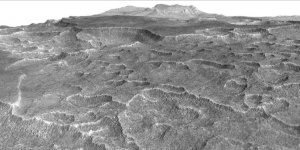| Space |
NASA Pluto-Bound Spacecraft Crosses Neptune's Orbit
NASA | SEPTEMBER 18, 2014
NASA's Pluto-bound New Horizons spacecraft has traversed the orbit of Neptune. This is its last major crossing en route to becoming the first probe to make a close encounter with distant Pluto on July 14, 2015.

During August 16 and 17, 1989, the Voyager 2 narrow-angle camera was used to photograph Neptune almost continuously, recording approximately two and one-half rotations of the planet. Image credit: NASA/JPL
The sophisticated piano-sized spacecraft, which launched in January 2006, reached Neptune's orbit -- nearly 4.4. billion kilometers from Earth -- in a record eight years and eight months. New Horizons' milestone matches precisely the 25th anniversary of the historic encounter of NASA's Voyager 2 spacecraft with Neptune on Aug. 25, 1989.
New Horizons now is about nearly 4 billion kilometers from Neptune -- nearly 27 times the distance between Earth and our sun -- as it crosses the giant planet's orbit at 7:04 p.m. PDT (10:04 p.m. EDT) Monday, August 25. Although the spacecraft will be much farther from the planet than Voyager 2's closest approach, New Horizons' telescopic camera was able to obtain several long-distance "approach" shots of Neptune on July 10.
Several senior members of the New Horizons science team were young members of Voyager's science team in 1989. Many remember how Voyager 2's approach images of Neptune and its planet-sized moon Triton fueled anticipation of the discoveries to come. They share a similar, growing excitement as New Horizons begins its approach to Pluto.
Voyager's visit to the Neptune system revealed previously unseen features of Neptune itself, such as the Great Dark Spot, a massive storm similar to, but not as long-lived, as Jupiter's Great Red Spot. Voyager also, for the first time, captured clear images of the ice giant's ring system, too faint to be clearly viewed from Earth.
Many researchers feel the 1989 Neptune flyby -- Voyager's final planetary encounter -- might have offered a preview of what's to come next summer.
Scientists suggest that Triton, with its icy surface, bright poles, varied terrain and cryovolcanoes, is a Pluto-like object that Neptune pulled into orbit. Scientists recently restored Voyager's footage of Triton and used it to construct the best global color map of that strange moon yet -- further whetting appetites for a Pluto close-up.
There is a lot of speculation over whether Pluto will look like Triton, and how well they'll match up.
Similar to Voyager 1 and 2's historic observations, New Horizons also is on a path toward potential discoveries in the Kuiper Belt, which is a disc-shaped region of icy objects past the orbit of Neptune, and other unexplored realms of the outer solar system and beyond.
Voyager 1 and 2 were launched 16 days apart in 1977, and one of the spacecraft visited Jupiter, Saturn, Uranus and Neptune.
Voyager 1 now is the most distant human-made object, about 19 billion kilometers away from the sun. In 2012, it became the first human-made object to venture into interstellar space. Voyager 2, the longest continuously operated spacecraft, is about 15 billion kilometers away from our sun.
YOU MAY ALSO LIKE





